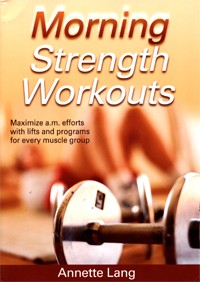 |
|
Fitness Tip of the Day!
|
|
Fitness of California Kids
|
|
In 2011, California reported that only 31% of 5th-9th grade students were physically fit. This represents a DECLINE of 3% from the prior year (CA. Dept. Education, Nov. 2011).
|
|
 |
 |
 |
|
 |
|
|
Morning Strength Workouts
|

|
| Author: |
Lang A |
| Category: |
Strength Training |
| Audience: |
Consumer |
| Length: |
223 pages |
| Publisher: |
Human Kinetics |
| Year Published: |
2007 |
| List Price: |
$16.95 |
|
|
|
|
AthleteInMe.com®
Rating:


 Good
Good
Morning Strength Workouts is one of 4 exercise books from Human Kinetics with a similar title.
• Recommended for: all consumers, from beginning exercisers to weekend warriors.
ABOUT THE AUTHOR
Annette Lang, MA, is a fitness trainer in New York. She has been a Reebok University instructor since 1996. She has a masters degree in health education and offers instruction and online courses through www.PTOnTheNet.com. She has been a speaker at IHRSA and IDEA World Fitness Convention.
CONTENT
The 223-page book is organized as follows:
PART I: A.M. READINESS
- Chapter 1: Energy to Begin Your Day
- Chapter 2: Your Workout Environment
- Chapter 3: Selecting Your Equipment
- Chapter 4: Muscles Into Action
- Chapter 5: Developing Your Training Program
PART II: WORKOUTS FOR EVERY SCHEDULE
- Chapter 6: 20-Minute Programs
- Chapter 7: 30-Minute Programs
- Chapter 8: 45-Minute Programs
- Chapter 9: 60-Minute Programs
PART III: MORNING EXERCISES
- Chapter 10: Upper Body
- Chapter 11: Core
- Chapter 12: Lower Body
REVIEW
Generally, Morning Strength Workouts contains some good information.
Chapters 1-3 and chapter 5 are essentially overview and background information on topics such as nutrition, sleep, motivation, equipment, and designing a program. Much of this information could be condensed. In some cases, Lang's writing style is tedious (ie., readers don't need to be reminded to keep their water bottle in the refrigerator to keep it cold...). The nutrition section of chapter 1 should be deleted. Not only is it extraneous to the title of the book, Lang introduces her own personal bias into what people should consume ("drink caffeine-free herbal tea," and "I don't support drinking protein shakes").
Further, her knowledge of nutritional biochemistry is suspect: "Pure sugar is assigned a glycemic index of 100 because your body does not need to break it down any further." (p. 10) (In fact, glycemic index reflects the blood glucose response, and, sugar, ie., sucrose, is broken down into glucose and fructose.).
The relevant material in this book really begins in chapter 4, which is a good chapter on stretching and warming up. However, unlike other discussions where the author provides too much detail, Lang's discussion of "medical clearance" (p. 40) omits some important concepts. Here, I feel she should be much more explicit regarding who should obtain medical clearance. While the Canadian PAR-Q form is reproduced on pages 41-42 and covers some of these specifics, the font is extremely small.
Chapter 5 is essentially another planning/getting ready chapter. It's one of the better chapters, but it seems more logical to present this chapter before chapter 4.
Chapters 6-9 present specific workout routines, based on length. These chapters are done well, with each routine being represented by a series of thumbnail black-and-white images of each specific exercise. However, the number of recommended sets and reps is buried in the text. Also, several exercises within each program require gym equipment (weight machines, cable machines, stability ball, etc.) For each exercise, the reader is referred to other pages for more specific information on that exercise.
Chapters 10-12 offer detailed information and larger black-and-white photos for each exercise. This section of the book is done well. My only criticism of these exercises is that exercises where the client bends forward at the waist and performs unsupported dumbbell exercises are demonstrated. I believe this is a good way to strain the lower back and feel these should not be done.
My final thought is that when I first picked up Morning Strength Workouts, I assumed that it was going to discuss working out at home. Certainly, many people hit the gym in the morning, but it would have been helpful to see some routines in chapters 6-9 that readers can do at home.
• What I Liked About This Book: The core information, ie., chapters 6-12, are useful. The images in chapters 10-12 are large, and, I liked that they presented 2 images for each exercise. This clearly illustrates to the reader how to perform the exercise.
• What Could Be Better: Eliminate the nutrition discussion in chapter 1; condense chapters 2-5; include some photos of older subjects; create some routines that can be done at home that do not require any special exercise equipment.
SUMMARY
Morning Strength Workouts is a decent resource for weekend warriors, but it can be a little frustrating to read. In an attempt to be comprehensive, I feel Lang tries to cover too much. Some of the exercises in each program require gym equipment.
| Reviewed by: Stan Reents, PharmD |
10/28/2016 8:57:40 AM |
|
|
 |
|
 |
|
|
|
 |
 |